Machine Learning-Assisted Comparative Analysis of Fracture Propagation Mechanisms in CO2 and Hydraulic Fracturing of Acid-Treated Tight Sandstone
Abstract
1. Introduction
2. Methodology
2.1. Transformer AI Model Training Method
2.2. Training AE Data Acquisition
2.3. Testing Schemes
3. AI Model Construction
3.1. AI Model Pre-Training Processes
3.2. AI Model Fine-Tune Processes
3.3. AI Model Performance Evaluation
3.4. AI Model Classification Mechanism
4. Fracturing Propagation Under 3D Stress
4.1. Spatiotemporal Evolution of Fracture Types
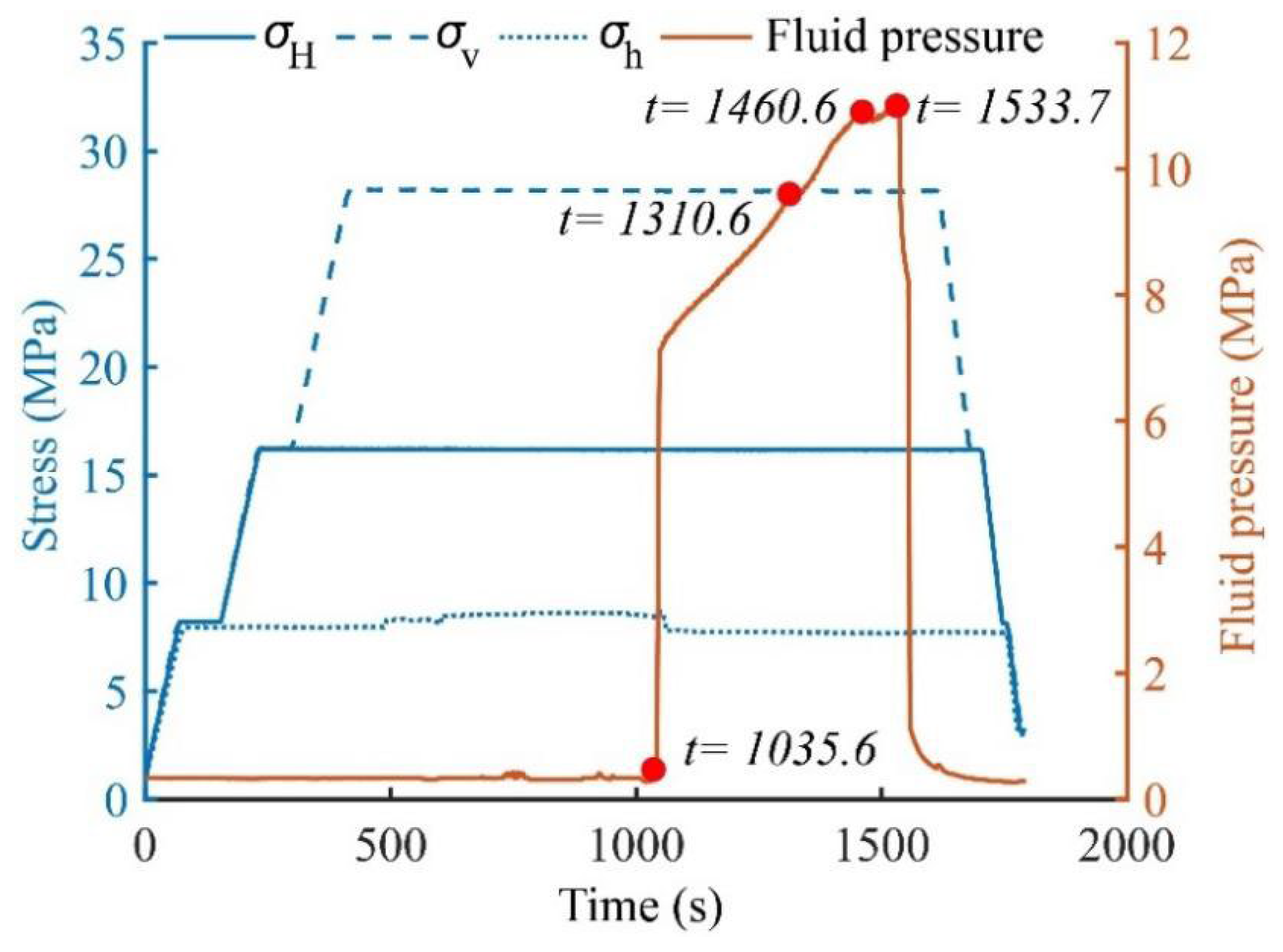
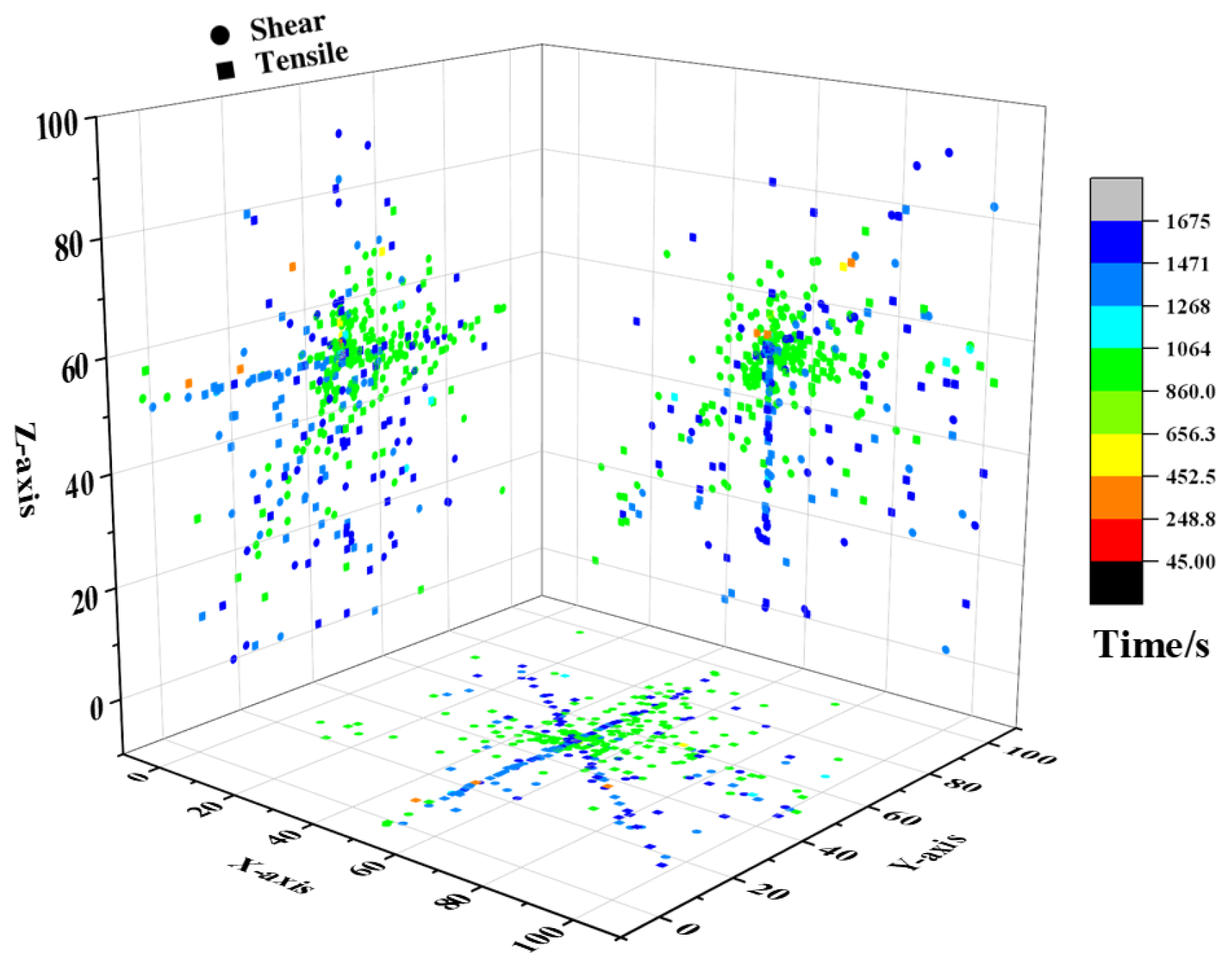

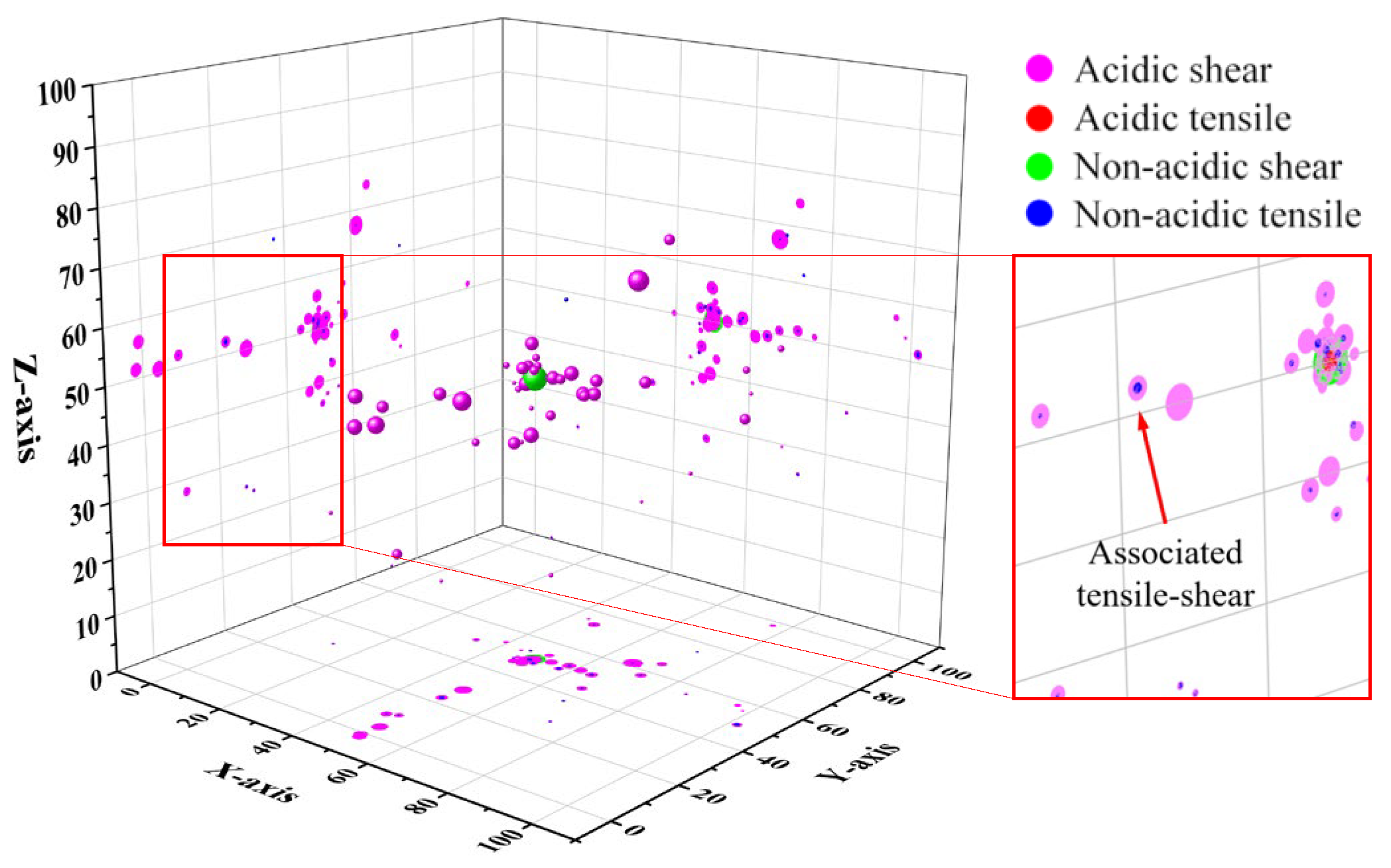


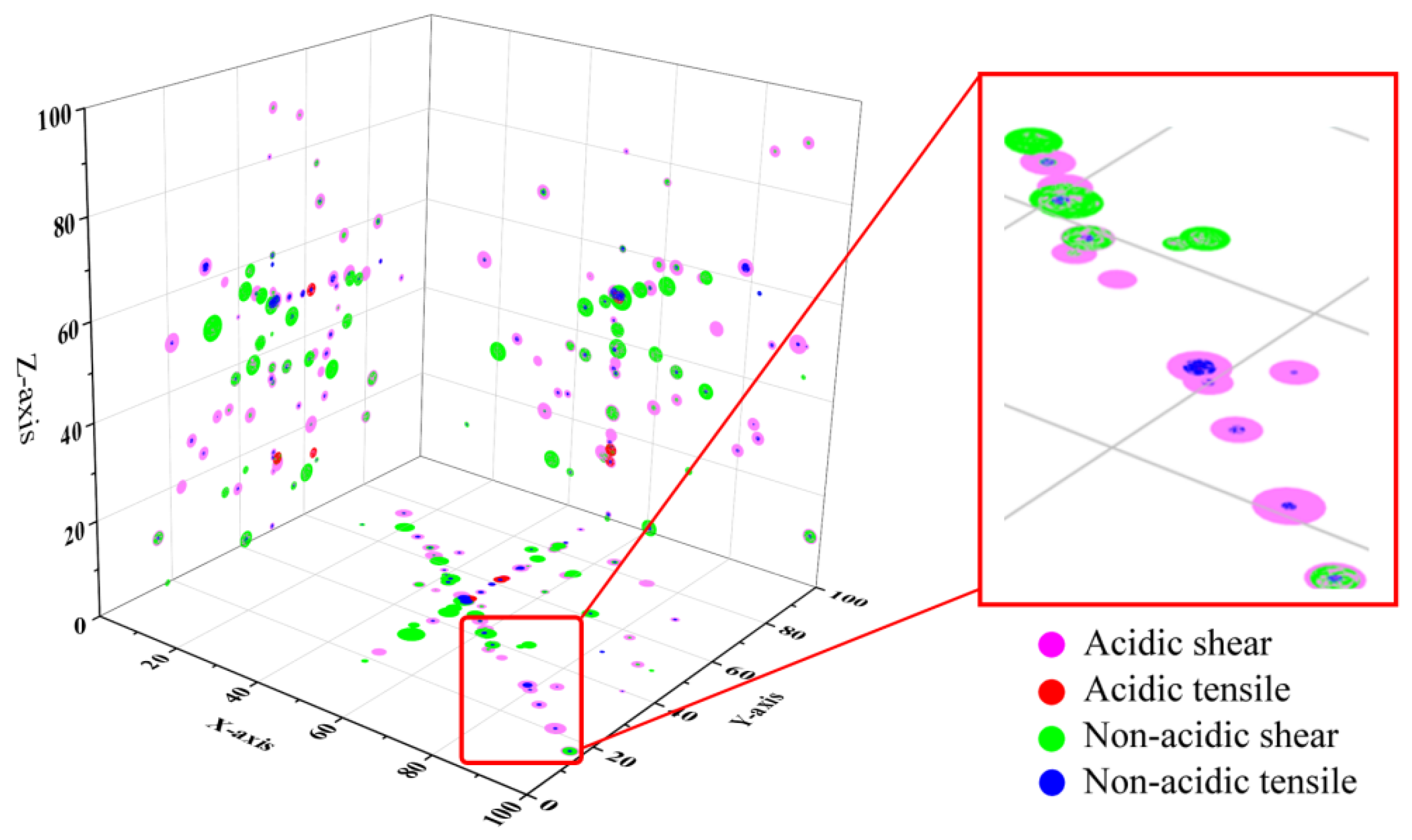
4.2. Fracture Evolution During Acidic Hydraulic Fracturing
5. Discussion
- (1)
- CO2 proactively weakens the tight sandstone by degrading its cementation (reducing cohesion) and reducing the effective stress counteracting shear failure, leading to complex fracture networks at lower pressures;
- (2)
- A well-trained AI model developed through a combination of unsupervised and supervised learning effectively identified AE waveforms corresponding to different crack types, including acidic tensile, acidic shear, non-acidic tensile, and non-acidic shear, with an accuracy of up to 95.4%;
- (3)
- Acid treatment dissolves part of the cementing material in the sandstone, increasing its brittleness. Consequently, the AE waveforms generated during fracture exhibit higher energy distribution in the high-frequency domain, a characteristic that aligns closely with the AE time-frequency patterns observed in tensile fractures;
- (4)
- During the CO2 fracturing process, the specimen tends to generate acidic shear fractures preferentially along the acidified weak planes under shear stress. When a dominant fracture direction is present, these acidic shear fractures further induce the formation and propagation of non-acidic shear and tensile cracks. Acidification thus reduces the local shear strength of the sandstone and accelerates fracture propagation;
- (5)
- Due to the significantly lower diffusivity of water compared to CO2, hydraulic fracturing predominantly induces non-acidized mixed-mode (tensile-shear) fractures. This fundamental difference in fracture patterns accounts for the higher initiation pressure observed in hydraulic fracturing compared to CO2 fracturing.
Author Contributions
Funding
Institutional Review Board Statement
Informed Consent Statement
Data Availability Statement
Conflicts of Interest
References
- Chen, P.; Hu, C.; Zou, P.; Lin, L.; Lu, S.; Gao, X. Pressure Response of a Horizontal Well in Tight Oil Reservoirs with Stimulated Reservoir Volume. Lithosphere 2021, 2021, 5383603. [Google Scholar] [CrossRef]
- Ibrahim, A.U.; Negash, B.M.; Rahman, M.T.; Suleiman, A.; Kwaku, D.D. A Mathematical Model for Estimating Effective Stimulated Reservoir Volume. J. Petrol. Explor. Prod. Technol. 2022, 12, 1775–1784. [Google Scholar] [CrossRef]
- Zhang, J.; Zheng, H.; Wang, G.; Liu, Z.; Qi, Y.; Huang, Z.; Fan, X. In-Situ Stresses, Abnormal Pore Pressures and Their Impacts on the Triassic Xujiahe Reservoirs in Tectonically Active Western Sichuan Basin. Mar. Pet. Geol. 2020, 122, 104708. [Google Scholar] [CrossRef]
- Ito, T. Effect of Pore Pressure Gradient on Fracture Initiation in Fluid Saturated Porous Media: Rock. Eng. Fract. Mech. 2008, 75, 1753–1762. [Google Scholar] [CrossRef]
- Wang, J.; Huang, Y.; Zhou, F.; Song, Z.; Liang, X. Study on Reservoir Damage during Acidizing for High-Temperature and Ultra-Deep Tight Sandstone. J. Petrol. Sci. Eng. 2020, 191, 107231. [Google Scholar] [CrossRef]
- Zou, Y.; Li, N.; Ma, X.; Zhang, S.; Li, S. Experimental Study on the Growth Behavior of Supercritical CO2-Induced Fractures in a Layered Tight Sandstone Formation. J. Nat. Gas Sci. Eng. 2018, 49, 145–156. [Google Scholar] [CrossRef]
- Azeez, R.S.; Tõnsuaadu, K.; Einard, M.; Kaljuvee, T.; Trikkel, A. Dissolution kinetics of rare earth elements from Estonian phosphate rock using hydrochloric acid treatment. Miner. Eng. 2025, 233, 109641. [Google Scholar] [CrossRef]
- Li, N.; Chen, F.; Yu, J.; Han, P.; Kang, J. Pre-Acid System for Improving the Hydraulic Fracturing Effect in Low-Permeability Tight Gas Reservoir. J. Petrol. Explor. Prod. Technol. 2021, 11, 1761–1780. [Google Scholar] [CrossRef]
- Zhao, X.; Guo, J.; He, E.; Lu, L.; Wang, H. Development of the Coupled Elastoplastic Damage Constitutional Model of Acidized Shale Gas Formation Based on Experimental Study. J. Geophys. Eng. 2019, 16, 332–344. [Google Scholar] [CrossRef]
- Vásárhelyi, B.; Narimani, S.; Davarpanah, S.M.; Mocsár, G. Modeling Brittle-to-Ductile Transitions in Rock Masses: Integrating the Geological Strength Index with the Hoek–Brown Criterion. Appl. Mech. 2024, 5, 634–645. [Google Scholar] [CrossRef]
- Liu, B.; Suzuki, A.; Ito, T. Numerical Analysis of Different Fracturing Mechanisms between Supercritical CO2 and Water-Based Fracturing Fluids. Int. J. Rock Mech. Min. Sci. 2020, 132, 104385. [Google Scholar] [CrossRef]
- Anderson, R.A.; Ingram, D.S.; Zanier, A.M. Determining Fracture Pressure Gradients from Well Logs. J. Petrol. Technol. 1973, 25, 1259–1268. [Google Scholar] [CrossRef]
- Liu, S.; Zhang, L.; Su, X.; Zhao, L.; Wang, Y. Micro-CT Characterization on Pore Structure Evolution of Low-Permeability Sandstone under Acid Treatment. Appl. Geochem. 2023, 152, 105633. [Google Scholar] [CrossRef]
- Deng, B.; Yin, G.; Li, M.; Zhang, D.; Lu, J.; Liu, Y.; Chen, J. Feature of Fractures Induced by Hydrofracturing Treatment Using Water and L-CO2 as Fracturing Fluids in Laboratory Experiments. Fuel 2018, 226, 35–46. [Google Scholar] [CrossRef]
- Li, X.; Lei, X.; Li, Q. Injection-Induced Fracturing Process in a Tight Sandstone under Different Saturation Conditions. Environ. Earth Sci. 2016, 75, 1466. [Google Scholar] [CrossRef]
- Ma, D.; Cheng, C.; Ding, C.; Song, J.; Hu, D.; Zhou, H. Comparisons of Fracturing Mechanism of Tight Sandstone Using Liquid CO2 and Water. J. Nat. Gas Sci. Eng. 2021, 94, 104108. [Google Scholar] [CrossRef]
- Li, S.; Zhang, S.; Ma, X.; Zou, Y.; Li, N.; Chen, M.; Cao, T.; Bo, Z. Hydraulic Fractures Induced by Water-/Carbon Dioxide-Based Fluids in Tight Sandstones. Rock Mech. Rock Eng. 2019, 52, 3323–3340. [Google Scholar] [CrossRef]
- Chen, W.; Konietzky, H.; Liu, C.; Tan, X. Hydraulic Fracturing Simulation for Heterogeneous Granite by Discrete Element Method. Comput. Geotech. 2018, 95, 1–15. [Google Scholar] [CrossRef]
- Zhang, Y.; He, J.; Li, X.; Lin, C. Experimental Study on the Supercritical CO2 Fracturing of Shale Considering Anisotropic Effects. J. Petrol. Sci. Eng. 2019, 173, 932–940. [Google Scholar] [CrossRef]
- Ma, D.-D.; Chen, Q.; Zhou, H.; Teng, Q.; Li, K.; Hu, D.-W. Experimental Study of Liquid CO2 Fracturing Mechanism of Glutenite. Rock Soil Mech. 2020, 41, 3996–4004. [Google Scholar] [CrossRef]
- Li, N.; Zhang, S.; Zou, Y.; Ma, X.; Zhang, Z.; Li, S.; Chen, M.; Sun, Y. Acoustic Emission Response of Laboratory Hydraulic Fracturing in Layered Shale. Rock Mech. Rock Eng. 2018, 51, 3395–3406. [Google Scholar] [CrossRef]
- Majer, E.L.; Doe, T.W. Studying Hydrofractures by High Frequency Seismic Monitoring. Int. J. Rock Mech. Min. Sci. Geomech. Abstr. 1986, 23, 185–199. [Google Scholar] [CrossRef]
- Ishida, T.; Chen, Y.; Bennour, Z.; Yamashita, H.; Inui, S.; Nagaya, Y.; Naoi, M.; Chen, Q.; Nakayama, Y.; Nagano, Y. Features of CO2 Fracturing Deduced from Acoustic Emission and Microscopy in Laboratory Experiments. J. Geophys. Res. Solid Earth 2016, 121, 8080–8098. [Google Scholar] [CrossRef]
- Turhan, F.; Cambaz, M.D.; Zahradník, J. The Significance of Crustal Velocity Model in Moment Tensor Solutions: A Case Study of Yedisu Earthquakes. In Moment Tensor Solutions: A Useful Tool for Seismotectonics; D’Amico, S., Ed.; Springer International Publishing: Cham, Switzerland, 2018; pp. 557–572. [Google Scholar] [CrossRef]
- Grosse, C.; Ohtsu, M. (Eds.) Acoustic Emission Testing; Springer Berlin Heidelberg: Berlin/Heidelberg, Germany, 2008. [Google Scholar] [CrossRef]
- Ohtsu, M. Moment Tensor Analysis. In Acoustic Emission Testing: Basics for Research—Applications in Engineering; Grosse, C.U., Ohtsu, M., Aggelis, D.G., Shiotani, T., Eds.; Springer International Publishing: Cham, Switzerland, 2022; pp. 197–219. [Google Scholar] [CrossRef]
- Shiotani, T.; Ohtsu, M.; Ikeda, K. Detection and evaluation of AE waves due to rock deformation. Constr Build Mater. 2001, 15, 235–246. [Google Scholar] [CrossRef]
- Shiraiwa, T.; Tamura, K.; Enoki, M. Analysis of kinking and twinning behavior in extruded Mg–Y–Zn alloys by acoustic emission method with supervised machine learning technique. Mater. Sci. Eng. A 2019, 768, 138473. [Google Scholar] [CrossRef]
- Ji, H.W.; Lee, H.; Hwang, I. Supervised learning-based classification of acoustic emission and vibration signal for identifying condition change of district heating system. Measurement 2023, 220, 113388. [Google Scholar] [CrossRef]
- Goodfellow, I.; Bengio, Y.; Courville, A. Deep Learning; The MIT Press: Cambridge, MA, USA, 2016. [Google Scholar]
- Bengio, Y.; Courville, A.; Vincent, P. Representation Learning: A Review and New Perspectives. IEEE Trans. Pattern Anal. Mach. Intell. 2013, 35, 1798–1828. [Google Scholar] [CrossRef]
- He, K.; Chen, X.; Xie, S.; Li, Y.; Dollár, P.; Girshick, R. Masked Autoencoders Are Scalable Vision Learners. In Proceedings of the IEEE/CVF Conference on Computer Vision and Pattern Recognition (CVPR), New Orleans, LA, USA, 21–24 June 2022; pp. 15979–15988. [Google Scholar]
- Li, M.; Yin, G.; Xu, J.; Cao, J.; Song, Z. Permeability Evolution of Shale under Anisotropic True Triaxial Stress Conditions. Int. J. Coal Geol. 2016, 165, 142–148. [Google Scholar] [CrossRef]
- Sun, Z.; Qiuhua, R.; Guiyao, W. Study on Determination of Shear Fracture Toughness. J. Rock Mech. Eng. 2002, 21, 199–203. [Google Scholar]
- Rui, Y.; Chen, J.; Du, J.; Peng, X.; Zhou, Z.; Zhu, C. Optimizing Microseismic Sensor Networks in Underground Space Using Cramér-Rao Lower Bound and Improved Genetic Encoding. Undergr. Space 2025, 23, 307–326. [Google Scholar] [CrossRef]
- Rui, Y.; Chen, J.; Pu, Y.; Du, X. An Innovative Analytical Solution of AE/MS Source Location with Singular Value Decomposition and Weight Estimation. Measurement 2025, 253, 117652. [Google Scholar] [CrossRef]
- Chen, J.; Gui, Z.; Rui, Y.; Zhao, X.; Pan, X.; Wang, Q.; Pu, Y.; Li, Z.; Liu, M. A Dual Attention-Based Deep Learning Model for Lithology Identification While Drilling. J. Rock Mech. Geotech. Eng. 2025, in press. [Google Scholar] [CrossRef]
- Ito, T.; Hayashi, K. Physical Background to the Breakdown Pressure in Hydraulic Fracturing Tectonic Stress Measurements. Int. J. Rock Mech. Min. Sci. 1991, 28, 285–293. [Google Scholar] [CrossRef]

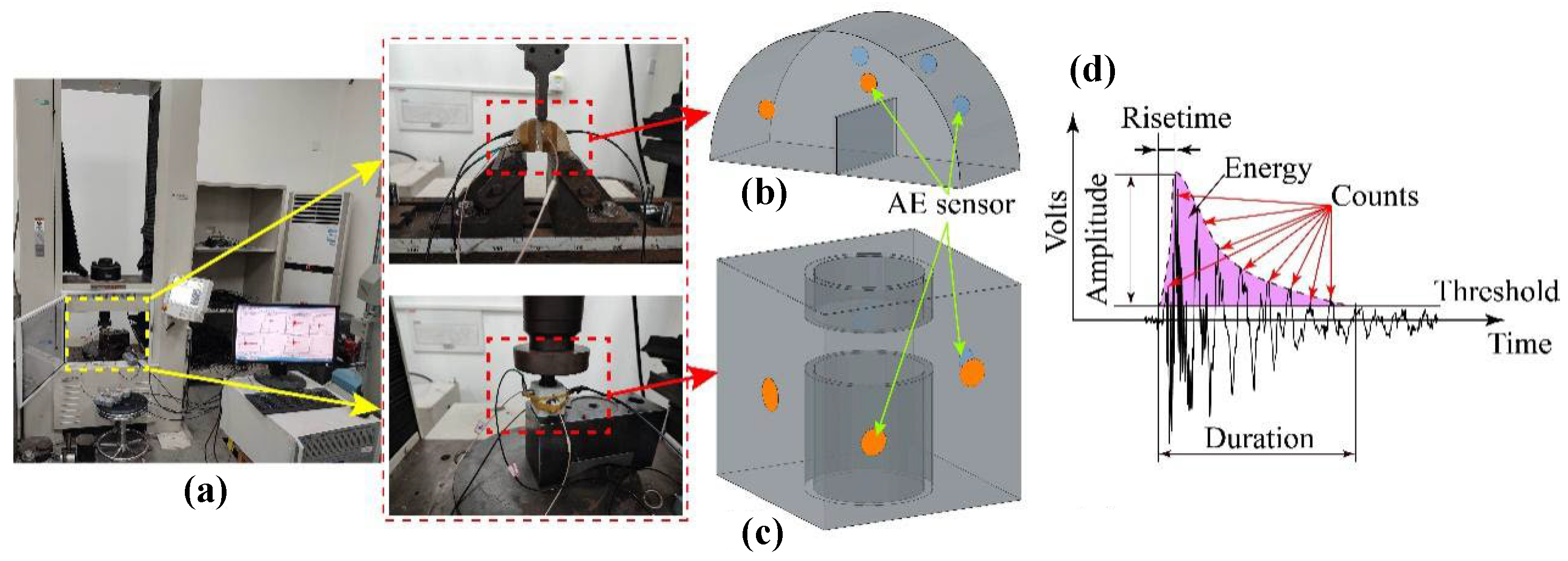
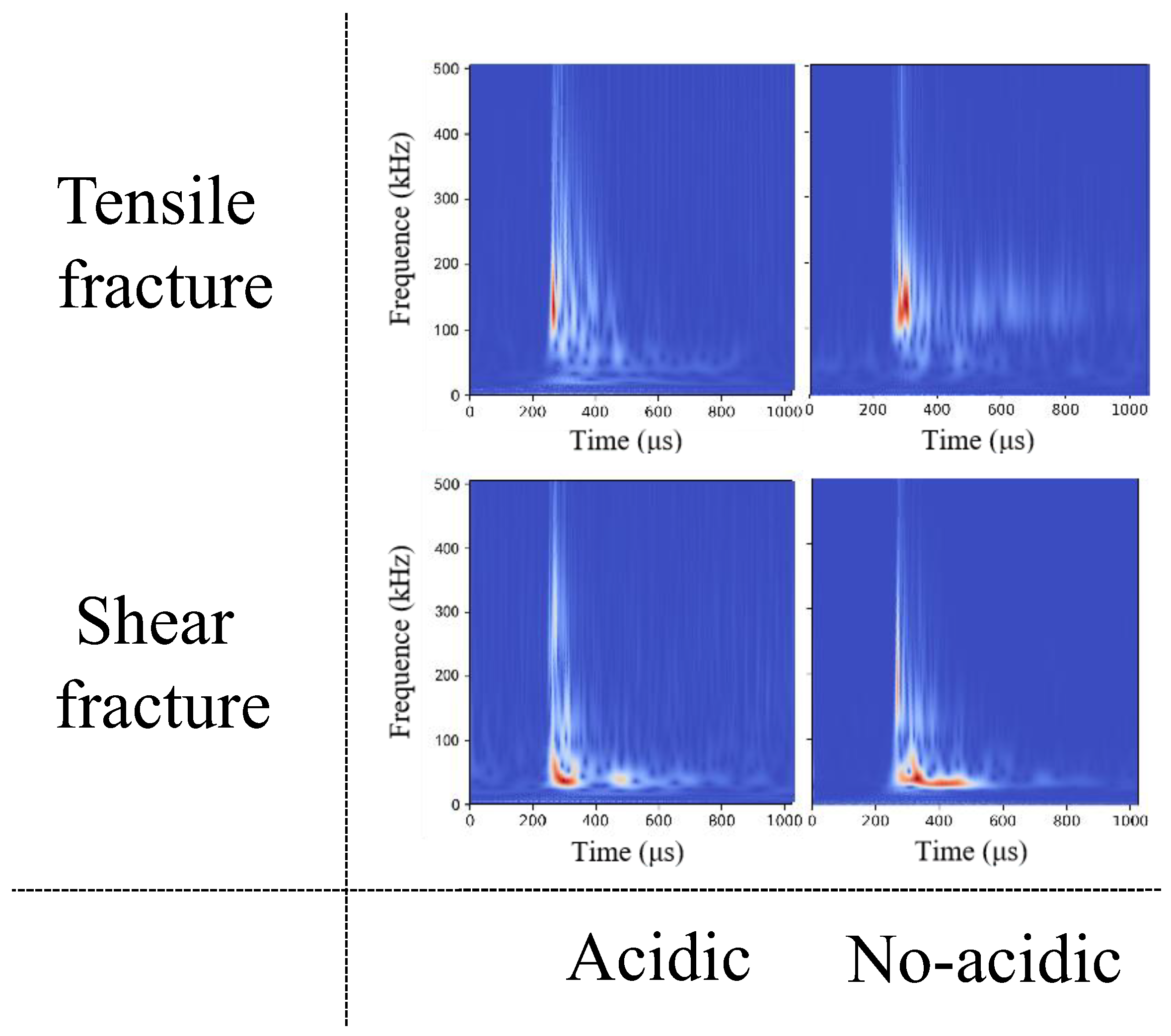




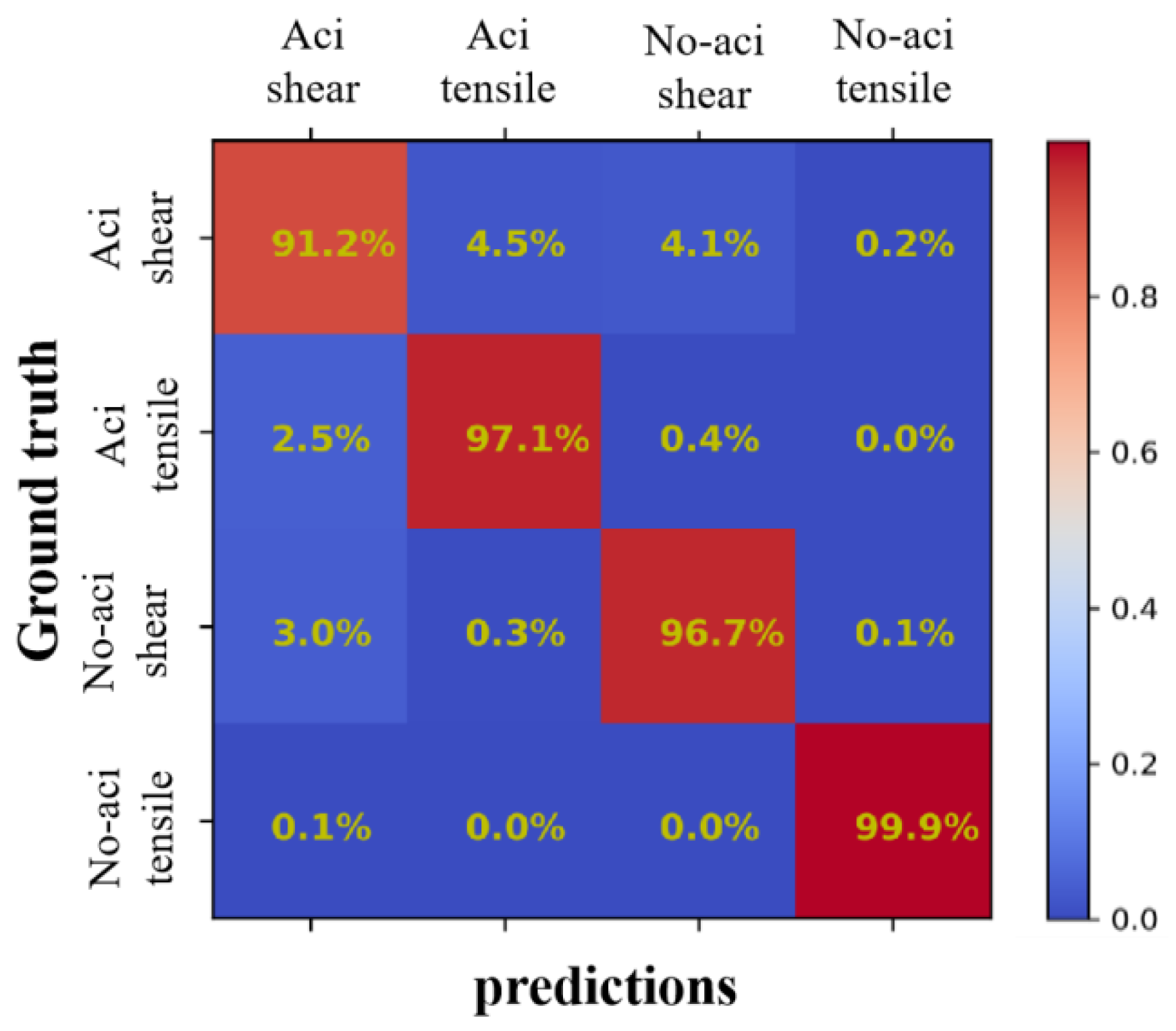


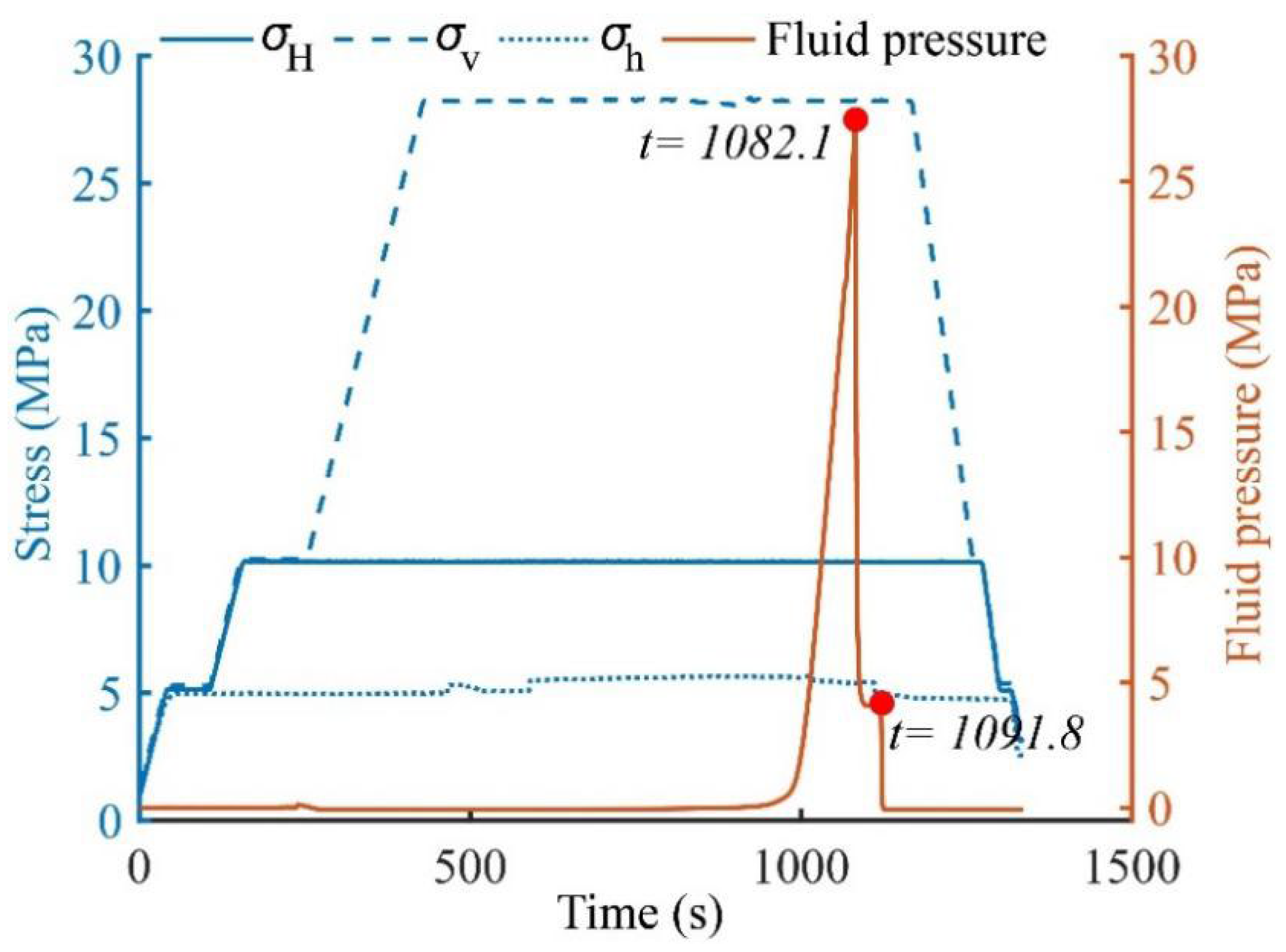
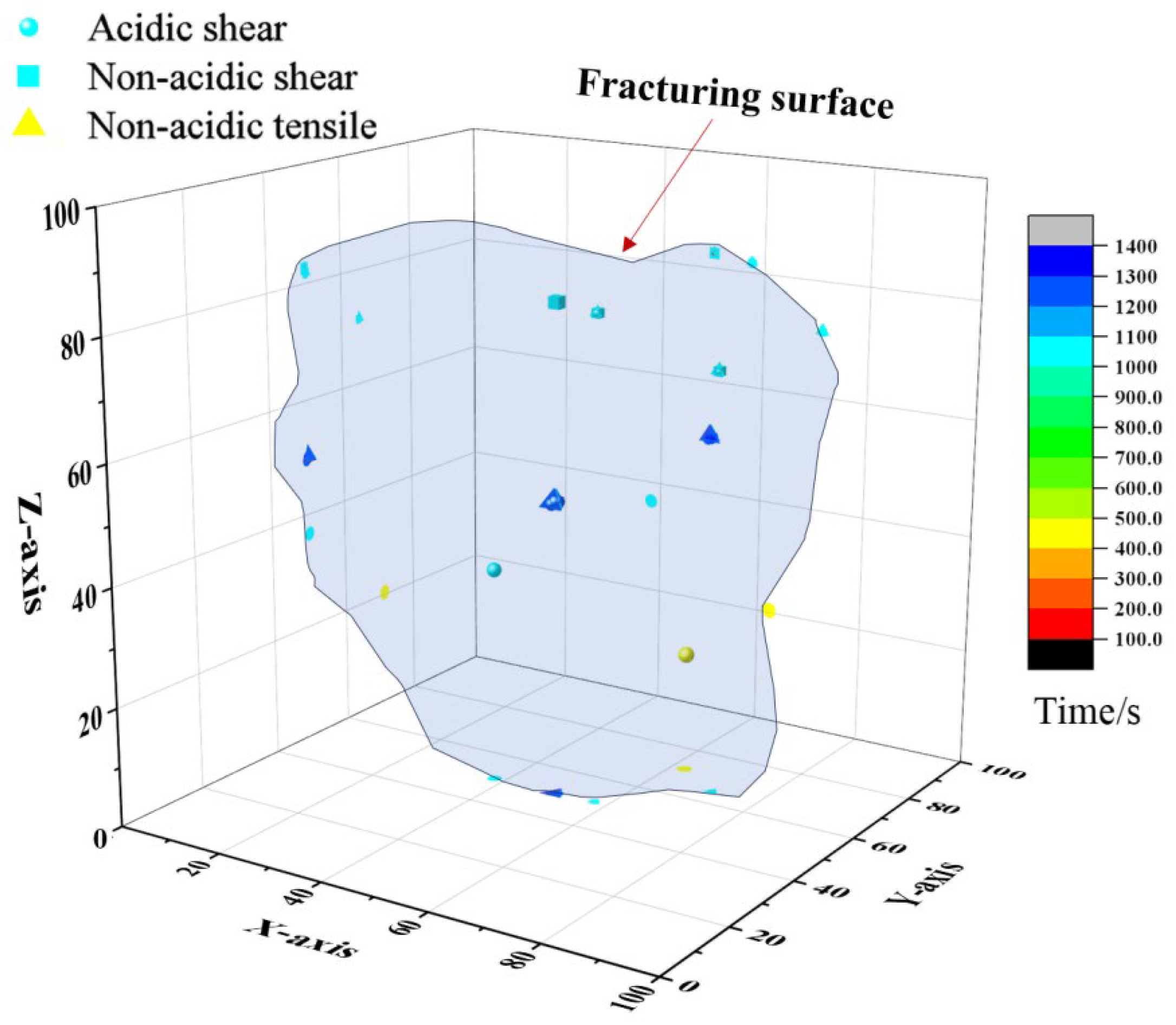
| Specimen Number | Peak Load (kN) | Breaking Energy (J/m2) | Fracture Toughness (MPa/m2) | ||
|---|---|---|---|---|---|
| Experimental Value | Mean Value | Experimental Value | Mean Value | ||
| I-1w | 1.73 | 201.54 | 237.70 | 0.91 | 1.06 |
| I-2w | 2.31 | 273.85 | 1.21 | ||
| I-4a | 1.59 | 207.36 | 198.83 | 0.83 | 0.86 |
| I-5a | 1.68 | 187.74 | 0.88 | ||
| I-6a | 1.67 | 201.40 | 0.87 | ||
| Specimen Number | Peak Load (kN) | Maximum Tangential Displacement (mm) | Shear Strength (MPa) | Shear Fracture Energy (J/m2) | |||
|---|---|---|---|---|---|---|---|
| Experimental Value | Mean Value | Experimental Value | Mean Value | Experimental Value | Mean Value | ||
| II-1 | 1.73 | 0.32 | 0.31 | 19.68 | 19.16 | 2658.27 | 2466.94 |
| II-6 | 2.31 | 0.30 | 18.64 | 2275.61 | |||
| II-3 | 1.59 | 0.33 | 0.458 | 18.82 | 16.17 | 2488.84 | 2487.03 |
| II-4 | 1.68 | 0.63 | 13.57 | 2816.44 | |||
| II-5 | 1.67 | 0.41 | 16.13 | 2155.82 | |||
| Specimen | Full Waveform Dataset | Select Waveform Dataset | Training Dataset | Testing Dataset | ||
|---|---|---|---|---|---|---|
| Piercing Shear Testing | Three-Point Bending | Piercing Shear Testing | Three-Point Bending | |||
| Sandstone | 20,832 | 17,856 | 17,856 | 17,856 | 28,569 | 7143 |
| Specimen Number | σv\σh\σH (MPa) | Injection Flow Rate (mL/min) | Fracturing Fluids | |
|---|---|---|---|---|
| 1# | 28\8\16 | 240 | CO2 | |
| 2# | 28\5\10 | 40 | fracturing fluid | |
Disclaimer/Publisher’s Note: The statements, opinions and data contained in all publications are solely those of the individual author(s) and contributor(s) and not of MDPI and/or the editor(s). MDPI and/or the editor(s) disclaim responsibility for any injury to people or property resulting from any ideas, methods, instructions or products referred to in the content. |
© 2025 by the authors. Licensee MDPI, Basel, Switzerland. This article is an open access article distributed under the terms and conditions of the Creative Commons Attribution (CC BY) license (https://creativecommons.org/licenses/by/4.0/).
Share and Cite
Huang, J.; Song, Z.; Geng, W.; Liang, Q. Machine Learning-Assisted Comparative Analysis of Fracture Propagation Mechanisms in CO2 and Hydraulic Fracturing of Acid-Treated Tight Sandstone. Appl. Sci. 2025, 15, 9822. https://doi.org/10.3390/app15179822
Huang J, Song Z, Geng W, Liang Q. Machine Learning-Assisted Comparative Analysis of Fracture Propagation Mechanisms in CO2 and Hydraulic Fracturing of Acid-Treated Tight Sandstone. Applied Sciences. 2025; 15(17):9822. https://doi.org/10.3390/app15179822
Chicago/Turabian StyleHuang, Jie, Zhenlong Song, Weile Geng, and Qinming Liang. 2025. "Machine Learning-Assisted Comparative Analysis of Fracture Propagation Mechanisms in CO2 and Hydraulic Fracturing of Acid-Treated Tight Sandstone" Applied Sciences 15, no. 17: 9822. https://doi.org/10.3390/app15179822
APA StyleHuang, J., Song, Z., Geng, W., & Liang, Q. (2025). Machine Learning-Assisted Comparative Analysis of Fracture Propagation Mechanisms in CO2 and Hydraulic Fracturing of Acid-Treated Tight Sandstone. Applied Sciences, 15(17), 9822. https://doi.org/10.3390/app15179822





